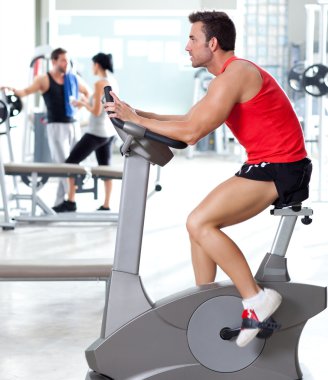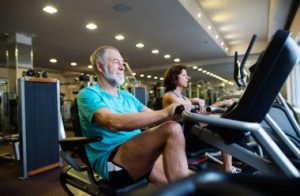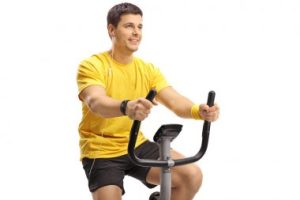
Can An Exercise Bike Help You Lose Weight (7 Important Facts)
Can an exercise bike help you lose weight? Embarking on a weight loss journey can be daunting, but with the right tools and strategies, achieving your goals becomes attainable. One such tool that has gained immense popularity is the exercise bike. In a world where time seems to sprint ahead while our waistlines sometimes lag behind, the quest to shed those stubborn pounds becomes an epic journey.
Amidst the cacophony of fitness trends and miracle diets, one stalwart contender emerges: the humble exercise bike. Picture this: the rhythm of pedals turning, the beat of your heart syncing with your efforts, and the promise of a leaner, stronger you just a workout away. But can this mechanical marvel truly be the knight in shining armor for your weight loss aspirations? Strap in, because you’re about to embark on a ride through the science, the sweat, and the sheer determination that make the exercise bike a formidable ally in the battle of the bulge.

Can An Exercise Bike Help You Lose Weight
Yes, an exercise bike can indeed help you lose weight effectively.
Burning Calories with Every Pedal
The fundamental principle behind weight loss is burning more calories than you consume. An exercise bike serves as a powerhouse in this regard, allowing you to engage in high-intensity workouts that incinerate calories rapidly. By pedaling away on the bike, you elevate your heart rate, leading to increased calorie expenditure.
Efficient Cardiovascular Workouts
Cardiovascular exercises are pivotal for shedding excess weight, and the exercise bike offers an efficient means to achieve this. With customizable resistance levels and various workout programs, you can tailor your sessions to target fat loss effectively. Consistent cycling on the bike not only enhances your cardiovascular health but also aids in trimming down body fat.
Low-Impact, High-Intensity Sessions
Unlike running or other high-impact exercises, cycling on an exercise bike places minimal stress on your joints. This makes it an ideal option for individuals with joint issues or those prone to injuries. Despite its low-impact nature, the bike enables you to engage in high-intensity interval training (HIIT), a proven method for accelerating weight loss and improving overall fitness.
Consistency and Accountability
One of the key factors in successful weight loss is consistency. An exercise bike offers the convenience of working out from the comfort of your home, eliminating excuses related to weather or time constraints. Additionally, many modern bikes come equipped with features such as progress tracking and virtual coaching, keeping you accountable and motivated on your journey.
Understanding Weight Loss
Caloric deficit principle
Understanding weight loss begins with grasping the caloric deficit principle. This principle revolves around consuming fewer calories than the body expends. It’s about burning more calories than you consume. “Caloric deficit” refers to the shortfall between calories eaten and calories burned. It’s the foundation of effective weight loss. By creating a caloric deficit, you prompt the body to tap into stored fat for energy. This process leads to gradual weight loss over time.
Role of exercise in weight loss
Exercise plays a pivotal role in weight loss by offering a multifaceted approach to achieving and maintaining a healthy body weight. Firstly, it aids in burning calories and fat, contributing to a calorie deficit necessary for shedding pounds. Regular exercise also boosts metabolism, enhancing the body’s ability to burn calories efficiently even at rest.
Moreover, it helps preserve lean muscle mass, which is essential for sustaining a higher metabolic rate. Additionally, exercise promotes overall well-being, reducing stress and enhancing mood, which can prevent emotional eating and support adherence to healthy eating habits. Importantly, a consistent exercise regimen fosters long-term weight management by promoting lifestyle changes rather than quick-fix solutions.
Benefits of cardiovascular exercise
Cardiovascular exercise, often referred to as cardio, offers a myriad of benefits that extend beyond just physical fitness. Engaging in activities like running, swimming, or cycling can significantly improve heart health by strengthening the heart muscle and enhancing its efficiency. Moreover, cardiovascular exercise plays a crucial role in weight management by burning calories and increasing metabolism, thus aiding in weight loss or maintenance.
Beyond the physical, cardio workouts have profound mental health benefits, as they release endorphins, neurotransmitters that promote feelings of happiness and reduce stress. Regular cardio exercise also boosts cognitive function, improving memory, focus, and overall brain health. Additionally, it promotes better sleep patterns, enhances energy levels, and increases longevity. Ultimately, integrating cardiovascular exercise into one’s routine not only enhances physical well-being but also fosters a healthier mind and overall quality of life.
Mechanism of an Exercise Bike
Description of an exercise bike
An exercise bike, also known as a stationary bike or indoor cycle, is a fitness machine designed for cardiovascular workouts. It mimics the motion of cycling outdoors but is stationary, with pedals, a seat, and handlebars for stability. Exercise bikes come in various designs, including upright, recumbent, and spin bikes, catering to different preferences and fitness goals.
How an exercise bike works
The mechanism of an exercise bike involves pedaling against resistance to simulate cycling. When you pedal, the flywheel, connected to the pedals via a chain or belt drive system, rotates, creating resistance. This resistance can be adjusted manually or electronically to increase or decrease the intensity of the workout. The user can control the speed and resistance levels, providing a customizable and efficient way to burn calories and improve cardiovascular health.
Types of exercise bikes
Upright Exercise Bikes
The upright exercise bike stands as a stalwart companion in the realm of home fitness, offering a convenient and effective means of cardiovascular exercise. With its straightforward design, the upright bike provides users with a comfortable yet challenging workout experience. Positioned in an upright stance, mimicking the posture of outdoor cycling, it engages a multitude of muscle groups, including the quadriceps, hamstrings, calves, and glutes. Its adjustable seat and handlebars accommodate various body types and preferences, ensuring a personalized workout session for every user.
Equipped with resistance settings, riders can tailor their intensity levels, making it suitable for both beginners and seasoned fitness enthusiasts alike. Beyond its physical benefits, the upright exercise bike often features built-in consoles offering tracking metrics such as speed, distance, time, and calories burned, empowering users to monitor their progress and stay motivated towards their fitness goals. Whether as a standalone fitness tool or as part of a comprehensive home gym setup, the upright exercise bike stands as a reliable and versatile option for individuals seeking to enhance their cardiovascular health and overall fitness.

Recumbent Exercise Bikes
Recumbent exercise bikes offer a comfortable and effective solution for individuals seeking low-impact cardiovascular workouts. Designed with a reclined seating position and a backrest, these bikes provide excellent support for the lower back, making them ideal for those with back issues or joint pain. The ergonomic design promotes proper posture and reduces strain on the body during exercise sessions.
With adjustable resistance levels and pre-programmed workout routines, users can customize their workouts to suit their fitness levels and goals. Recumbent bikes are also known for their quiet operation, making them suitable for home use without causing disruptions. Whether for rehabilitation purposes, weight loss, or general fitness improvement, recumbent exercise bikes offer a convenient and accessible option for users of all ages and fitness levels to engage in regular physical activity.

Spin Bikes
The spin bike, a staple in gyms and homes alike, represents a revolution in cardiovascular fitness. Designed to simulate the experience of outdoor cycling, spin bikes offer users an intense and dynamic workout that targets various muscle groups, particularly the legs, core, and cardiovascular system. With adjustable resistance levels and handlebar configurations, spin bikes cater to individuals of all fitness levels, allowing for customizable workouts that can challenge both beginners and seasoned athletes.
The rhythmic motion of pedaling coupled with motivating music or instructor-led classes creates an immersive and energizing exercise experience. Beyond its physical benefits, the spin bike fosters a sense of community and camaraderie, often found in group cycling classes, inspiring individuals to push their limits and achieve their fitness goals. Whether aiming to improve endurance, burn calories, or simply enjoy a high-intensity workout, the spin bike stands as a versatile and effective tool for achieving optimal fitness and well being.

How Exercise Bikes Aid Weight Loss
Calorie burning during exercise
Intensity and calorie expenditure
Intensity plays a crucial role in determining the calorie expenditure during physical activity. When exercise intensity increases, the body requires more energy to meet the demands placed upon it. This elevated demand prompts a higher calorie burn.
High-intensity activities such as sprinting, HIIT (High-Intensity Interval Training), or vigorous aerobic exercises like running or cycling at a fast pace, lead to greater calorie expenditure compared to low or moderate-intensity activities like walking or gentle cycling. The body’s metabolic rate also stays elevated post-exercise following high-intensity workouts, further contributing to calorie expenditure. Thus, understanding and manipulating exercise intensity can be a key strategy in achieving specific fitness goals, whether it be weight loss, cardiovascular health, or endurance enhancement.
Duration of exercise sessions
The duration of exercise sessions varies widely depending on individual fitness goals, physical condition, and exercise intensity. For beginners, starting with shorter sessions, typically around 20 to 30 minutes, can be more manageable and less overwhelming. As fitness levels improve, sessions can gradually extend to 45 minutes to an hour or longer.
High-intensity interval training (HIIT) often involves shorter bursts of intense exercise followed by brief periods of rest, usually totaling 20 to 30 minutes. Endurance athletes may engage in prolonged sessions lasting several hours to build stamina and endurance. Ultimately, the key is finding a duration that challenges the body appropriately while allowing for adequate recovery, thereby supporting overall health and fitness goals. Consulting with a fitness professional can help determine the most suitable duration for individual needs and objectives.
Impact on metabolism
EPOC (Excess Post-Exercise Oxygen Consumption)
EPOC, short for Excess Post-Exercise Oxygen Consumption, refers to the increased rate of oxygen intake following strenuous physical activity. This phenomenon occurs due to the body’s need to restore depleted oxygen levels, metabolize lactic acid, and repair muscle tissues after exercise.
EPOC plays a crucial role in calorie expenditure, as the body continues to burn calories at an elevated rate during this recovery period. This post-exercise oxygen consumption contributes to overall energy expenditure, making it an essential factor in weight management and fitness training programs. The intensity and duration of exercise, as well as individual fitness levels, influence the magnitude and duration of EPOC. Understanding EPOC is vital for optimizing workout routines and achieving fitness goals effectively.
Long-term metabolic changes
Long-term metabolic changes refer to alterations in the body’s biochemical processes that occur over an extended period, often resulting from lifestyle habits, dietary patterns, and genetic factors. These changes can profoundly influence an individual’s overall health and well-being. For instance, prolonged consumption of a high-calorie, low-nutrient diet may lead to metabolic syndrome, characterized by insulin resistance, obesity, and elevated blood pressure.
Conversely, sustained adherence to a balanced diet and regular exercise can promote favorable metabolic adaptations, such as improved insulin sensitivity and lipid profile. Additionally, aging itself brings about metabolic shifts, including decreased muscle mass and a slower metabolic rate. Understanding and managing long-term metabolic changes are crucial for preventing chronic diseases like diabetes, cardiovascular disorders, and obesity, highlighting the importance of adopting healthy lifestyle practices to support metabolic health throughout life.
Muscle engagement and toning
Lower body muscles involved
When pedaling on an exercise bike, a variety of lower body muscles engage to propel the motion. The primary muscles involved include the quadriceps, located on the front of the thigh, which contract to extend the knee as the pedal is pushed down. Additionally, the hamstrings, situated at the back of the thigh, play a crucial role in the pedal stroke as they help to flex the knee during the upstroke phase.
The gluteal muscles, particularly the gluteus maximus, are activated to stabilize the hips and provide power during the downward push of the pedal. Furthermore, the calf muscles, including the gastrocnemius and soleus, are recruited to point the toes downward, completing the pedal revolution. Engaging in regular exercise biking not only strengthens these lower body muscles but also improves cardiovascular health and endurance.
Incorporating upper body workout for more calorie burn
Incorporating upper body workouts while using an exercise bike can significantly enhance calorie burn and overall fitness. By engaging the muscles of the arms, shoulders, and back, cyclists can amplify the intensity of their workout, leading to greater calorie expenditure and improved cardiovascular health. Introducing movements such as arm curls, shoulder presses, or even simply maintaining an active arm motion throughout the ride can increase the workload on the body, resulting in a more comprehensive and efficient workout.
Additionally, integrating upper body exercises helps promote muscle balance and coordination, contributing to a more holistic and effective fitness regimen. Whether using light hand weights, resistance bands, or bodyweight exercises, combining upper body movements with cycling not only maximizes calorie burn but also adds variety and excitement to the workout routine.
Factors Affecting Weight Loss with Exercise Bikes
Intensity of workouts
High-intensity interval training (HIIT)
The effectiveness of weight loss with exercise bikes is influenced by various factors, including the intensity of workouts and the incorporation of high-intensity interval training (HIIT). Intensity plays a crucial role in calorie expenditure and fat loss, as higher-intensity workouts typically burn more calories in a shorter period. By adjusting resistance levels and pedaling speed, individuals can tailor their workouts to achieve different levels of intensity, thus maximizing their weight loss potential.
Additionally, integrating HIIT sessions into exercise bike routines can further enhance results. HIIT involves alternating between short bursts of intense exercise and brief recovery periods, which has been shown to boost metabolism and promote fat burning even after the workout is completed. Therefore, by carefully managing workout intensity and incorporating HIIT techniques, individuals can optimize their weight loss journey with exercise bikes.
Steady-state cardio
Several factors significantly influence weight loss when utilizing exercise bikes, with workout intensity being a primary determinant. The intensity of workouts directly impacts the number of calories burned during cycling sessions. The concept of steady-state cardio, where individuals maintain a consistent pace for extended durations, plays a crucial role.
While not as metabolically demanding as HIIT, steady-state cardio still contributes to calorie burn and fat loss, particularly when sustained over longer periods. Balancing between these two approaches and adjusting workout intensity according to individual fitness levels and goals is key to optimizing weight loss outcomes with exercise bikes.
Frequency and consistency
Recommended workout frequency
The recommended workout frequency for utilizing an exercise bike typically depends on individual fitness goals, current fitness level, and overall health. For general cardiovascular health maintenance, experts often suggest aiming for at least three to five sessions per week, each lasting between 20 to 60 minutes.
However, for those seeking more significant weight loss or improvements in cardiovascular fitness, increasing the frequency to five to seven sessions per week can be beneficial. It’s crucial to allow for adequate rest days to prevent overtraining and allow muscles to recover. Additionally, varying the intensity and duration of workouts can help prevent plateaus and maintain motivation. Always consult with a healthcare professional or fitness expert to tailor a workout frequency that suits individual needs and abilities.
Importance of consistency
Consistency in using an exercise bike is paramount for achieving and maintaining physical fitness goals. Regular workouts on an exercise bike not only enhance cardiovascular health but also contribute to overall strength and endurance. The consistent engagement of muscles improves tone and flexibility while aiding in weight management.
Additionally, regular exercise promotes mental well-being by reducing stress and boosting mood through the release of endorphins. Establishing a routine and sticking to it ensures gradual progress and prevents setbacks. Consistency breeds habit, and incorporating exercise into daily life becomes easier over time, leading to a sustainable and healthier lifestyle. Whether aiming for weight loss, muscle building, or simply improving overall fitness, the importance of consistency in using an exercise bike cannot be overstated.
Nutrition and diet
Balanced diet for weight loss
A balanced diet is crucial for achieving weight loss goals effectively and sustainably. Aiming for a balance of macronutrients—such as carbohydrates, proteins, and healthy fats—ensures that the body receives essential nutrients while promoting satiety and regulating energy levels. Incorporating plenty of fresh fruits, vegetables, whole grains, and lean proteins like chicken, fish, tofu, or legumes provides vital vitamins, minerals, and fiber, while keeping calorie intake in check.
Limiting processed foods, sugary snacks, and excessive fats helps to reduce overall calorie consumption and promotes healthier eating habits. Additionally, staying hydrated by drinking plenty of water throughout the day aids digestion and can help prevent overeating. Striking this balance not only supports weight loss efforts but also promotes overall well-being and sustainable lifestyle changes.
Importance of hydration
Hydration plays a pivotal role in the journey of weight loss, serving as a fundamental pillar often overlooked in many weight management plans. Adequate hydration not only ensures optimal bodily functions but also aids significantly in the process of shedding excess pounds. Water serves as a natural appetite suppressant, curbing unnecessary cravings and promoting a sense of fullness, thus preventing overeating.
Furthermore, staying properly hydrated facilitates the efficient functioning of metabolism, enabling the body to burn calories more effectively. It also assists in the elimination of toxins and waste products, crucial for maintaining a healthy digestive system. Without proper hydration, the body’s ability to metabolize fat decreases, hindering weight loss efforts. Therefore, prioritizing hydration by consuming ample water throughout the day is imperative for those seeking to achieve their weight loss goals effectively and sustainably.
Additional Benefits of Exercise Bikes
Low-impact exercise
In addition to their primary function of providing cardiovascular workouts, exercise bikes offer a plethora of additional benefits, notably their low-impact nature. Unlike high-impact exercises such as running or jumping, cycling on an exercise bike puts minimal stress on the joints, making it an ideal option for individuals with joint issues or those recovering from injuries.
This low-impact feature allows people of all fitness levels to engage in effective workouts without risking injury or exacerbating existing conditions. Moreover, the smooth, repetitive motion of pedaling helps improve joint flexibility and mobility over time, making it an excellent choice for promoting overall joint health. Thus, exercise bikes not only facilitate cardiovascular fitness but also contribute significantly to maintaining joint functionality and overall well-being.
Convenience and accessibility
Exercise bikes offer numerous additional benefits beyond just physical fitness. One of the most notable advantages is their unparalleled convenience and accessibility. Unlike outdoor cycling or gym memberships, exercise bikes are available for use right in the comfort of one’s home. This accessibility means no commuting time or weather constraints, allowing individuals to seamlessly incorporate exercise into their daily routines.
Furthermore, exercise bikes offer a versatile workout option for people of all fitness levels, from beginners to advanced athletes, making them suitable for the whole family. With adjustable settings and customizable programs, users can tailor their workouts to meet their specific needs and goals. Additionally, the convenience of multitasking while exercising, such as catching up on emails or watching TV, adds to the appeal of exercise bikes as a time-efficient fitness solution.

Monitoring progress and setting goals
Exercise bikes come equipped with features for monitoring progress and setting fitness goals. Users can track metrics like distance, speed, and calories burned in real-time. Additionally, many models offer preset workout programs and the ability to customize workouts based on personal fitness objectives.
Potential Challenges and Solutions
Plateaus in weight loss
Experiencing a weight loss plateau can be frustrating and demotivating. To overcome plateaus, consider adjusting your calorie intake or increasing physical activity. Incorporating high-intensity interval training (HIIT) and strength training can rev up metabolism and break through plateaus effectively.
Boredom and monotony
Feeling bored with your workout routine is common and can hinder progress. Spice things up by trying new exercises or activities like yoga, dance classes, or outdoor workouts. Adding variety keeps workouts fresh and enjoyable, preventing monotony and maintaining motivation.
Physical limitations and injuries
Dealing with physical limitations or injuries requires caution and proper care. Focus on maintaining proper form and posture during exercises to prevent further injury. Seeking guidance from a certified trainer or physical therapist ensures safe and effective workouts tailored to your specific needs.
Frequently Asked Questions (FAQ) about Can An Exercise Bike Help You Lose Weight
Q1. How effective is using an exercise bike for weight loss?
A. Exercise bikes can be highly effective for weight loss when combined with a balanced diet and consistent exercise routine. They provide a cardiovascular workout that burns calories and helps to create a calorie deficit, which is essential for weight loss.
Q2. How often should I use an exercise bike to see weight loss results?
A. The frequency of exercise bike usage for weight loss depends on various factors, including your current fitness level, diet, and weight loss goals. Generally, aiming for at least 3-5 sessions per week of 30-60 minutes each can yield noticeable results over time.
Q3. What intensity level should I aim for during my exercise bike workouts?
A. The intensity level of your workouts should challenge you but also be sustainable for the duration of your session. High-intensity interval training (HIIT) or steady-state cardio sessions can both be effective for weight loss. Gradually increase intensity as your fitness improves.
Q4. Can I target specific areas for weight loss with an exercise bike?
A. While you can’t spot-reduce fat from specific areas of your body, regular exercise bike workouts can contribute to overall weight loss, which may lead to reductions in fat throughout your body, including trouble spots like the abdomen and thighs.
Q5. Is it necessary to combine exercise bike workouts with other forms of exercise for weight loss?
A. While exercise bikes provide an excellent cardiovascular workout, incorporating strength training and flexibility exercises into your routine can enhance weight loss and overall fitness. Additionally, varying your workouts helps prevent boredom and plateaus.
Q6. How soon can I expect to see weight loss results from using an exercise bike?
A. Weight loss results vary depending on individual factors such as metabolism, diet, and exercise consistency. Some people may notice changes within a few weeks, while for others, it may take longer. Remember, sustainable weight loss is gradual and requires patience.
Q7. Are there any dietary considerations I should keep in mind while using an exercise bike for weight loss?
A. While exercise is crucial for weight loss, maintaining a balanced diet is equally important. Focus on consuming nutrient-dense foods, controlling portion sizes, and staying hydrated to support your weight loss efforts.
Q8. Can using an exercise bike lead to muscle gain as well as weight loss?
A. While exercise bikes primarily target cardiovascular fitness and calorie burning, they can also strengthen and tone muscles in the legs, glutes, and core. Incorporating resistance or interval training can further enhance muscle development.
Q9. Are there any potential risks or precautions I should be aware of when using an exercise bike for weight loss?
A. It’s essential to use proper form and equipment when exercising to reduce the risk of injury. Additionally, if you have any pre-existing health conditions or concerns, consult with a healthcare professional before starting any new exercise regimen.
Conclusion
In conclusion, the exercise bike stands as a versatile and effective tool in the pursuit of weight loss. Its accessibility, convenience, and ability to provide low-impact yet high-intensity workouts make it an appealing option for individuals aiming to shed excess pounds. When coupled with a balanced diet and consistent exercise regimen, the exercise bike can contribute significantly to achieving weight loss goals.
Its capacity to engage multiple muscle groups and promote cardiovascular health underscores its value as a cornerstone of any fitness routine geared towards weight management. Embracing the exercise bike as part of a holistic approach to health and wellness can empower individuals to attain their desired weight loss outcomes, fostering not only physical transformation but also enhancing overall well-being and vitality.